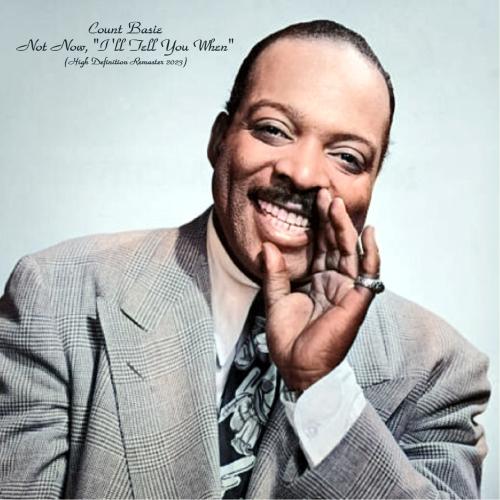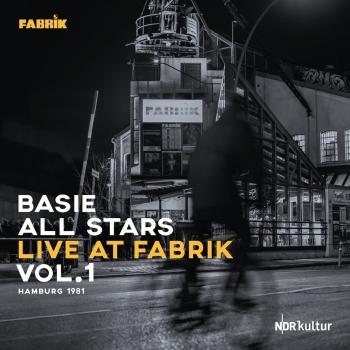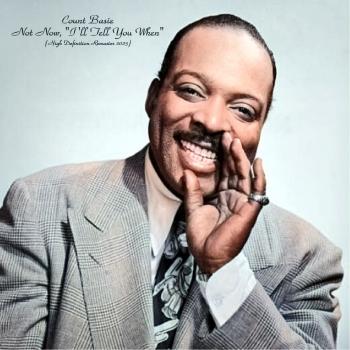
Not Now, "I'll Tell You When" (High Definition Remaster 2023) Count Basie
Album info
Album-Release:
2023
HRA-Release:
05.05.2023
Album including Album cover
- 1 Not Now, I'll Tell You When (Remastered 2023) 03:38
- 2 Rare Butterfly (Remastered 2023) 04:35
- 3 Back To The Apple (Remastered 2023) 04:43
- 4 Ol' Man River (Remastered 2023) 04:52
- 5 Mama's Talkin' Soft (Remastered 2023) 04:27
- 6 The Daly Jump (Remastered 2023) 04:08
- 7 Blue On Blue (Remastered 2023) 02:50
- 8 Swinging At The Waldorf (Remastered 2023) 03:41
- 9 Sweet And Purty (Remastered 2023) 03:23
Info for Not Now, "I'll Tell You When" (High Definition Remaster 2023)
Originally written under the title 'Super Chief,' this Thad Jones arrangement is now known as the title track from the Count Basie Orchestra's 1960 album 'Not Now, I'll Tell You When.' Jones's writing is at its creative peak throughout, making use of his trademark dissonant blasts alongside some deftly clever rhythmic tricks that make for an overall riveting listening experience.
As is the case with so many Basie arrangements, things start off with a brief solo piano introduction followed by a couple choruses of blues to set the mood. The full band enters at measure 22, with a rapidly rising melody line that begins in the band's bottom half before rising up to the upper reaches of the trumpets' registers. The band plays two excited, but relatively brief shout choruses at measures 30 and 55, with a couple more piano solo choruses sandwiched in-between. The energy level of the performance should be at close to full bore right from the start, and not let up throughout the entire arrangement.
The band officially claims the spotlight for itself at measure 80. A somewhat bop-influenced melody line here gives way to a more traditional call-and-response between the brass and the saxes at measure 92. The arrangement's blues form gets briefly elongated at this point to allow for drummer Sonny Payne to show off a bit at measure 100. The drum solo is followed by yet another joyously raucous ensemble shout at measure 108 before a recap of the introduction occurs. Jones finishes things off by dipping into his back catalogue, as the end of the arrangement is recycled from his composition 'Let's,' originally recorded in small group form in 1956. This section will require your band's internal metronomes to be operating at peak efficiency to prevent missteps, but when executed correctly it will undoubtedly create quite the thrill for performers and audiences alike.
This publication was prepared from Thad Jones's score and the original set of parts used during the 1960 recording session - this is not a transcription.
Count Basie, piano
Sonny Cohn, trumpet
Thad Jones, trumpet
Joe Newman, trumpet
Snooky Young, trumpet
Henry Coker, trombone
Al Grey, trombone
Benny Powell, trombone
Marshal Royal, alto saxophone, clarinet
Frank Wess, alto saxophone, tenor saxophone, flute
Frank Foster, tenor saxophone
Billy Mitchell, tenor saxophone
Charlie Fowlkes, baritone saxophone
Freddie Green, guitar
Eddie Jones, bass
Sonny Payne, drums
Digitally remastered
William "Count" Basie
Though a pianist and occasional organist, William "Count" Basie's fame stems mainly from his history as one of the great bandleaders. Basie's arrangements made good use of soloists, allowing musicians such as Lester Young, Buck Clayton, Sweets Edison, and Frank Foster to create some of their best work. Although his strength was as a bandleader, Basie's sparse piano style often delighted audiences with its swinging simplicity.
Basie's first teacher was his mother, who taught him piano. Later, the informal organ lessons from his mentor Fats Waller helped him find work in a theater accompanying silent films. In 1927, Basie found himself in Kansas City, playing with two of the most famous bands in the city: Walter Page's Blue Devils and the Bennie Moten band. In 1935, Basie started his own Kansas City band, engaging the core of the Moten band. They performed nightly radio broadcasts, which caught the attention of music producer John Hammond. In 1936, Hammond brought the Basie band to New York, where it opened at the Roseland Ballroom. By the next year, the band was a fixture on 52nd Street, in residence at the Famous Door.
During this time the key to Basie's band was what became known as the "All-American Rhythm Section"––Freddie Green on guitar, Walter Page on bass, and Jo Jones on drums. The horns were also quite potent, including Lester Young, Earl Warren, and Herschel Evans on saxophones; Buck Clayton and Sweets Edison on trumpets; and Benny Morton and Dicky Wells on trombones. With a swinging rhythm section and topnotch soloists in the horn section, Basie's band became one of the most popular between 1937- 49, scoring such swing hits as "One O'Clock Jump" and "Jumpin' at the Woodside." Lester Young's tenor saxophone playing during this period, in particular on such recordings as "Lester Leaps In" and "Taxi War Dance," influenced jazz musicians for years to come. In addition, Basie's use of great singers such as Helen Humes and Jimmy Rushing enhanced his band's sound and popularity.
Economics forced Basie to pare down to a septet in 1950. By 1952 he had returned to his big band sound, organizing what became euphemistically known as his "New Testament" band, which began a residency at Birdland in New York. The new band retained the same high standards of musicianship as the earlier version, with such standouts as Frank Foster, Frank Wess, Eddie "Lockjaw" Smith, Thad Jones, and Joe Williams. Foster's composition "Shiny Stockings" and Williams' rendition of "Every Day" brought Basie a couple of much-needed hits in the mid-1950s. In addition to achieving success with his own singers, he also enjoyed acclaim for records backing such stars as Frank Sinatra, Sammy Davis, Jr., and Tony Bennett. Basie continued to perform and record until his death in 1984.
This album contains no booklet.











